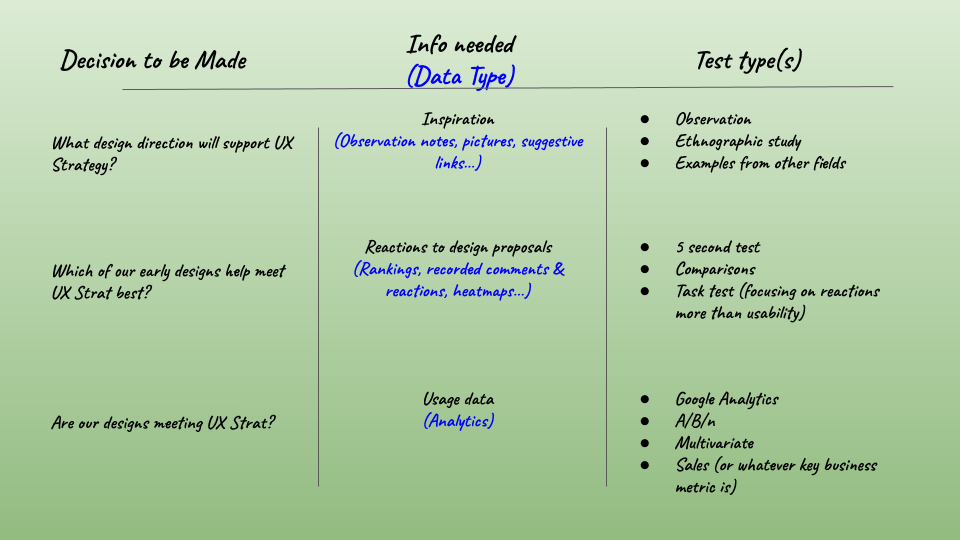UX Testing: Goals
TL;DR
UX Testing shouldn't be done as a general "data fishing" activity. Each round of tests should have clear and specific goals, specific information they seek to gain that will help designers make better decisions. If there is no decision in need of info, there should be no test.
What is a UX Test Goal?
The UX Test Goal is a statement that describes why you are conducting that specific test and what decision it will support. It can include the type of data needed to inform the decision.
For instance, the strategic goal the UX team is working toward is to design an experience for a physical, offline brand that will make users feel connected to each other and happy to be "on the team". They are now focusing on the mobile aspects of that experience.
The design process would require different types of information at different design phases hence different UX Testing Goals at each.
Inspiration
The team wants to get beyond what they've done before and what's common in the market. They require information that will spur thinking in new directions such as information on what motivates ad-hoc groups, supporters of kids' sports teams, or hashtag adoption. Because the information they want is observational, they elect an ethnographic testing approach.
Test Goal: Inspirational observations from on and offline worlds.
Design Selection
The team has roughed out several ideas in workshops. They need to get target-group specific reactions before making final design decisions. They will build prototypes to show participants. This round of testing will almost certainly require iterations of refined prototypes but for simplicity, I'll pretend just one.
Test Goal: To find which prototype best meets the UX Strategy.
Design Validation
The team has designed a mobile app intended to satisfy the strategy based on the previous testing rounds. They now need to verify their high-level mockups. They assume that basic usability is not going to be an issue so they won't specifically run task-based tests but will take not of any confusion, if any, they observe.
Test Goal: To verify (or falsify) that a majority of users report feelings that will support the strategic goal.
Product Validation
UX Testing won't guarantee success. The only way to test for success is to release the product and see how it performs. Often some aspects do well while others are disappointing and refinement is in order. To know what actually works well, the design team requires quantitative usage data.
Test Goal: To measure usage data and see if it meets design expectations.
 [Source: Nik Page]
[Source: Nik Page]
Why You Might Want UX Testing Goals
UX Testing costs resources and time. It generates data that should help drive product development but can mislead. Often, testing is done because it's a step in some Best Practices list and is little more than a To-Do item to be ticked. The data is gathered without any clear idea of what purpose it serves in the product development or business plan.
Writing down the goal encourages thinking about specifically WHY you want to run the test and what exact data you will gather. Knowing that helps you plan what type of testing with get it. It helps the testing team avoid overspending on testing and gathering useless or misleading data.
One tangential point, keep it simple. The ideal test gets a single key bit of information to inform a single, key decision. In real life, we often need to combine things but keep them as close to the ideal and as closely related as practical. Complexity increases opportunities for failure. This counts in testing as much as any other endeavor. Don't increase complexity without good reason.
Problems the UX Testing Goals Solves
- Gathering data that doesn't help any design or business decisions
- Running tests that gather the wrong data types
- Wasting money in testing
- Risk of acting on data that doesn't support the UX Strategy.
How to Implement a UX Testing Goals
Before writing test scripts or responded recruitment specifications on a whiteboard map out:
- UX Strategic Goal
- What specific decision(s) the design team needs to make at this time to support #1
- What information are they missing, what info do they need to do #2
- What kind of test will supply #3
- Write a bullet-point goal statement that supports #4
Common Pitfalls to a UX Testing Goals
- Not thinking about the goal in the hierarchal support structure listed above. Simply writing a few words without really understanding how it fits into the whole process is pointless.
Resources for the UX Strategy
Was the article helpful?
Want to write for DXKB?
Feel free to contribute. People from DXKB community will be more than happy.
Related articles
ALL ARTICLES
UX Strategy
UX Strategy gives the design of a user's experience a goal, a plan to reach it, and ways to measure progress and success without which, the project is just a bunch of activities that might lead somewhere but probably not there, where you want it.
Read moreUX Prototyping
A prototype is a model of a system (in our case an app, web, business process, or UI) built to test elements of the intended system. It is not primarily a final design candidate or MVP.
Read moreJobs To Be Done
Jobs To Be Done (JTBD) is a theory for understanding the process of consumer life’s transformation. The usage of JTBD improves your product design.
Read moreALL ARTICLES
Contribution
We are happy you want to contribute to DXKB. Please choose your preferred way